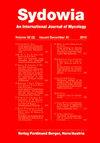Fungal Systematics and Evolution: FUSE 6
IF 1.2
4区 生物学
Q4 MYCOLOGY
引用次数: 20
Abstract
Fungal Systematics and Evolution (FUSE) is one of the journal series to address the “fusion” between morphological data and molecular phylogenetic data and to describe new fungal taxa and interesting observations. This paper is the 6th contribution in the FUSE series—presenting one new genus, twelve new species, twelve new country records, and three new combinations. The new genus is: Pseudozeugandromyces (Laboulbeniomycetes, Laboulbeniales). The new species are: Albatrellopsis flettioides from Pakistan, Aureoboletus garciae from Mexico, Entomophila canadense from Canada, E. frigidum from Sweden, E. porphyroleucum from Vietnam, Erythrophylloporus flammans from Vietnam, Marasmiellus boreoorientalis from Kamchatka Peninsula in the Russian Far East, Marasmiellus longistipes from Pakistan, Pseudozeugandromyces tachypori on Tachyporus pusillus (Coleoptera, Staphylinidae) from Belgium, Robillarda sohagensis from Egypt, Trechispora hondurensis from Honduras, and Tricholoma kenanii from Turkey. The new records are: Arthrorhynchus eucampsipodae on Eucampsipoda africanum (Diptera, Nycteribiidae) from Rwanda and South Africa, and on Nycteribia vexata (Diptera, Nycteribiidae) from Bulgaria; A. nycteribiae on Eucampsipoda africanum from South Africa, on Penicillidia conspicua (Diptera, Nycteribiidae) from Bulgaria (the first undoubtful country record), and on Penicillidia pachymela from Tanzania; Calvatia lilacina from Pakistan; Entoloma shangdongense from Pakistan; Erysiphe quercicola on Ziziphus jujuba (Rosales, Rhamnaceae) and E. urticae on Urtica dioica (Rosales, Urticaceae) from Pakistan; Fanniomyces ceratophorus on Fannia canicularis (Diptera, Faniidae) from the Netherlands; Marasmiellus biformis and M. subnuda from Pakistan; Morchella anatolica from Turkey; Ophiocordyceps ditmarii on Vespula vulgaris (Hymenoptera, Vespidae) from Austria; and Parvacoccum pini on Pinus cembra (Pinales, Pinaceae) from Austria. The new combinations are: Appendiculina gregaria, A. scaptomyzae, and Marasmiellus rodhallii. Analysis of an LSU dataset of Arthrorhynchus including isolates of A. eucampsipodae from Eucampsipoda africanum and Nycteribia spp. hosts, revealed that this taxon is a complex of multiple species segregated by host genus. Analysis of an SSU–LSU dataset of Laboulbeniomycetes sequences revealed support for the recognition of four monophyletic genera within Stigmatomyces sensu lato: Appendiculina, Fanniomyces, Gloeandromyces, and Stigmatomyces sensu stricto. Finally, phylogenetic analyses of Rhytismataceae based on ITS–LSU ribosomal DNA resulted in a close relationship of Parvacoccum pini with Coccomyces strobi.真菌分类学与进化:FUSE 6
真菌系统学与进化(FUSE)是一个系列期刊,旨在解决形态学数据和分子系统发育数据之间的“融合”,并描述新的真菌分类群和有趣的观察结果。这篇论文是FUSE系列的第六篇文章,介绍了一个新属、十二个新种、十二个新国家记录和三个新组合。新属是:假zeugandromyces(Laboulbeniomycetes,Laboulbaniales)。新种有:巴基斯坦的Albatrellopsis flettioides、墨西哥的Aureoboletus garciae、加拿大的Entomophila canasensise、瑞典的E.frigidum、越南的E.porphyroleucum、越南的红叶孢、俄罗斯远东堪察加半岛的Marasmilus boreorientalis、巴基斯坦的Marasmelus longistipes,来自比利时的钝口鲎(鞘翅目,Staphylinidae)、埃及的索氏Robillarda sohagensis、洪都拉斯的Trechispora hondurensis和土耳其的kenanii口蘑上的假zeugandromyces速孔菌。新的记录是:卢旺达和南非的非洲真双足目(Diptera,Nycteribidae)上的真双足节肢动物,以及保加利亚的长颈真双足纲(Nycteribia vexata)上的双足目,Nyctribidae;南非Eucampsipoda africanum上的A.nycteribiae、保加利亚的Penicillidia consicua(双翅目,Nycteribidae)上(第一个毫无疑问的国家记录)和坦桑尼亚的Penicilidia pachymela上;来自巴基斯坦的紫丁香Calvatia丁香;来自巴基斯坦的Entoloma shangdongense;来自巴基斯坦的酸枣(Rosales,Rhamnaceae)上的丹毒(Erysiphe querciola;来自荷兰的犬齿扇蚁属(双翅目,扇蚁科)上的角毛扇蚁属;来自巴基斯坦的Marasmilus biformis和M.subuda;土耳其产羊肚菌;奥地利小蜂属(膜翅目,小蜂科)上的小蜂草;以及奥地利松属松属(Pinales,Pinaceae)上的松Parvacoccus pini。新的组合是:合群Appendiculina gregria、舟状藻A.scaptomyzae和rodhallii Marasmelus。对节肢动物LSU数据集的分析表明,该分类单元是由多个按寄主属分离的物种组成的复合体,该数据集包括来自非洲真双足目(Eucampsipoda africanum)和尼氏菌属(Nycteribia spp.)的真双足纲A.eucampsipodae的分离株。对Laboulbeniomycetes序列的SSU–LSU数据集的分析表明,支持识别感兴趣的耻垢菌中的四个单系属:Appendiculina属、Fanniomyces属、Gloeandromyces属和感兴趣的严格耻垢菌属。最后,基于ITS–LSU核糖体DNA对Rhytismataceae进行系统发育分析,结果表明松球球菌与星球菌关系密切。
本文章由计算机程序翻译,如有差异,请以英文原文为准。
求助全文
约1分钟内获得全文
求助全文
来源期刊

Sydowia
生物-真菌学
CiteScore
3.30
自引率
10.00%
发文量
0
审稿时长
>12 weeks
期刊介绍:
Sydowia publishes reports of original research relevant to fungal taxonomy, systematics, evolution, structure, development, ecology, pathology (plants, animals, humans), and biotechnological applications. Reviews are published in areas of particular interest and current importance, but authors should consult the Editor before submitting a review manuscript. One volume of the journal, comprising two issues, is published each year. The official journal language is English. Submission of a manuscript to the Executive Editor implies that the results have not been previously published or simultaneously submitted to any other scientific journal, except as an abstract. When the authors are in doubt as to the suitability of their papers for Sydowia, the Editor of the journal should be consulted before submission of the manuscript.
All authors of a manuscript must have agreed to its submission and are responsible for its content. An author is one who has substantially contributed to the overall design and execution of the experiments. Individuals who supplied materials or critiqued the paper may be recognised in the acknowledgement section.
 求助内容:
求助内容: 应助结果提醒方式:
应助结果提醒方式:


